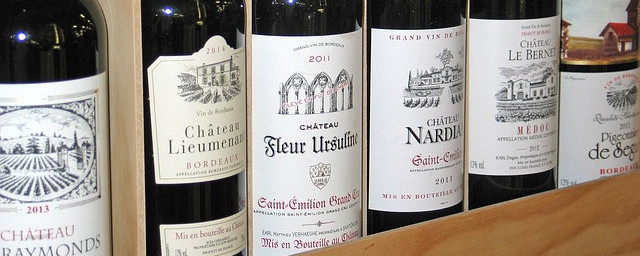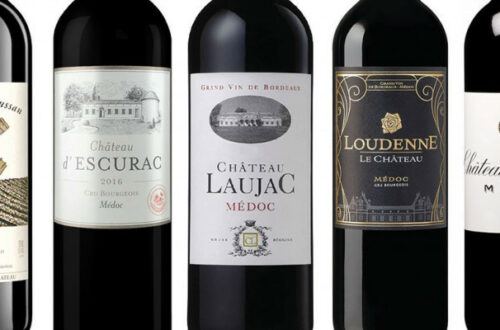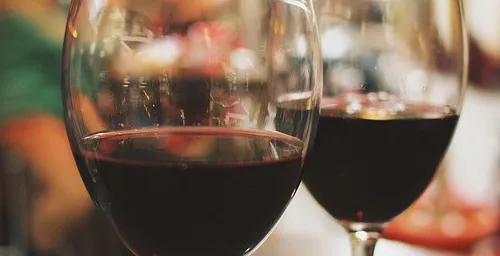
How to read a Bordeaux wine label?
When you go to your favorite wine shop or even a supermarket to buy the wine for a friend’s dinner, for a romantic evening or even just for yourself, the only thing working for you is the label…
So it’s important to know how to read it, which information you should be looking for and most importantly, clues on whether this wine is made for you (or not)
Let’s start with the obvious : the winerie
In Bordeaux, a winerie is either a “Château” or a “Domaine”.
If it has a castle, it is then called “Château” and the castle must be accurately represented on the label. When I say accurate, I mean accurate : it should have the exact count of windows or chimneys for example.
By the way, for the wineries which have several cuvées, the “Château” one will be their signature cuvée, so mostly the one with the highest quality.

The white wines’ label
Concerning the white wines, they may be dry or sweet, still or sparkling.
A sparkling wine will be specified with the word “Crémant” on the label. If there is no such thing, it’ll be a still wine.
If it’s a sweet wine, the term “moelleux” will often be indicated. The only time it isn’t specified is when the wine belongs to an AOC, such as Sauternes for example. (known for being a sweet wine).
Dry white wines can be mono-varietals made from Sauvignon Blanc, which has aromas of citrus and green fruit, or a blend from Sauvignon and Sémillon, which will still have high acidity but more body. The latter more often belongs to the Pessac-Léognan or Graves appellation.
Sweet wines are often a blend of Semillon with a hint of Muscadelle, which offers aromas of fresh grapes and flowers. Indeed, the semillon is the most widespread for the elaboration of sweet wines because of its thin film more prone to botrytis.
For the red wines, you want to know from which Bank the wines come from
Don’t forget, we are talking about reading a Bordeaux wine label. So we know we’re in France and more precisely in Bordeaux.
There, the concept of terroir is very important as is the vintage. But concerning the latter, we’ll come back to it later.
Wine is unique because of where it comes from in France. Controversy, in the USA, the grape variety will be more important.
In Bordeaux, which is subject to the vintage effect, will be mostly blends for the red wines. Indeed, relying on a unique grape variety would be too risky. However, the concept of soil and grape variety is very important in Bordeaux, so you want to know on which soils were the vines grown in order to guess the grape variety which will give you an indication of the taste of the wine.

In Bordeaux, it’s quite easy actually, the wine region is divided in two (some will say three with the Entre-Deux-Mers), but if we’re speaking “soil”, it’s mostly divided between the Right Bank and the Left Bank.
The Right Bank is mostly constituted of clay and clay-limestone soil, ideal for Merlot, whereas the Left Bank knows more gravel soils, ideal for Cabernet Sauvignon.
Thus, Right Bank wines will be Merlot dominated whereas Left Bank wines will be Cabernet Sauvignon dominated.
Does it come from the Right Bank or the Left Bank?
We now know which grape variety dominates the blend depending on the Bank. Okay, but can we identify which Bank we’re on?
The easiest way is to look out for the appellation. Can you find the words “Appellation d’Origine Contrôlée” (or AOP)? If so, just above, it should be mentioned which AOC (or AOP) (Margaux, Pauillac, Saint-Emilion, Pomerol….).
With the map just below, you can now identify the Bank.
For wines only called “Bordeaux” or “Bordeaux supérieur” : either the town is mentioned or the Internet becomes your best friend by looking up the localization of the “Château” or “Domaine”.
Why is the vintage important?
Most of the time, you will see a year printed on the label. This is called the vintage, it indicates the year when the grapes were harvested.
Seeing as in Bordeaux, there is a great vintage effect, you’ll want to notice the vintage.
Top Vintages for Red wines in Bordeaux are : 1961, 1970, 1978, 1982, 1985, 1990, 1996, 2000, 2005, 2009, 2010
Top Vintages for white wines in Bordeaux are : 1945, 1949, 1955, 1959, 1962, 1971, 1982, 1986, 1988, 1989, 1990, 1995, 1996, 2009.
This doesn’t mean you shouldn’t drink the others. It means, you should rather not wait too long before drinking them. When I say too long, I mean decades. If the wine is five years old or so, that’s great : you also don’t want the wine to be too young because the tannins might be harsh.
Other indications you may come across
The other mentions you may come across on the label is whether it’s a Cru Classé or not.
- A Left Bank wine may have Premier to Cinquième Cru Classé (First to Fifth Growth) written on the label, meaning it belongs to the classification of 1855
- A Saint-Emilion may have “Grand Cru Classé” or “Premier Grand Cru Classé A” or “Premier Grand Cru Classé B” written on the label, meaning it belongs to the Saint-Emilion classification
- On others, you may find “Grand Cru Classé de Graves”, meaning it is a wine that belongs to the Graves classification.

If you see the mentions “Vieilles Vignes” or “Grand Vin”, these have no legal value. They’re really up to the winemaker.
“Vieilles vignes” means “old vines”, but this means the grapes come from the oldest vines of the estate which doesn’t really say much… The vines could be five-year-old and still be the oldest… Same goes for “Grand Vin”, which doesn’t really mean anything. Some wineries may specify it in order to highlight that it is their best wine.
“Mis en bouteille” means bottled. This explains where the wine was bottled. You can also have the information by looking on the cap.
- If there is an “R”, which means “Récoltant”, it means the winegrower was also the winemaker and bottled his wine.
- If there is an “N”, it means “Négociant”, meaning the wine was bottled by the negociant and was probably produced from purchased grapes.
- If there is an “E”, it means “Exploitant”, meaning the vines belong to the person who did the bottling, but was neither the winegrower nor the winemaker.
Conclusion : How to read a Bordeaux wine label?
All in all, a lot of information may be read on a Bordeaux wine label.
A white wine will be rather straightforward, and with a little knowledge (that you will get on this website) and a good dictionary, you’ll know all you need to know with the information written on the label.
For red wines, it a little more complex. The easiest way to identify what the wine may taste like is by identifying the Bank it comes from. Once you did that, just read my article on What does Bordeaux wine taste like and you’re good to go!








4 Comments
Sariyah
Hey a great and interesting post you have here!
Though I don’t drink wine, I know a little information about them since I do buy them for my friends, this post has given me even more knowledge on what to look for the tastier wine.
I like how the features of the castle is constant throughout the wine labels it makes it more authentic and valuable.
Thanks for this read, have a great day!
Mademoiselle
Thank you Sariyah for stopping by and you’re welcome! I’m glad I could help
注册Binance
Your article helped me a lot, is there any more related content? Thanks! https://accounts.binance.info/en-IN/register-person?ref=UM6SMJM3
Mademoiselle
Thank you very much! You should have the related content underneath. Otherwise, just search “Bordeaux” in the search bar